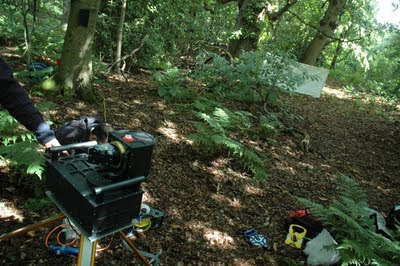 |
| The Riegl Z390 at plot 2 |
As a commercial unit, the Riegl is much quicker and simpler to set up, however we can only extract the first returns from the collected datasets. We are aiming to gather comparative gap fraction data to use against SALCA and the hemispherical photography. 2 ND0.6 filters were attached side by side to the receiving lens of the scanner as previous research has found the intensities saturate, making further analysis difficult. Using a resolution of 0.1 degrees in both the elevation and azimuth, we complete 2 6 minute scans at each plot (the second scan being positioned perpendicular to the first to collect the full hemisphere).
 |
| Alberto with the Riegl at plot 3 |
Building on Alberto's work, we have managed a full 'point-based' approach to gap fraction analysis, where the beam either hits a target 100% or not at all. This produces an underestimation of the gap fraction (the gap appears smaller) because sometimes only part of the beam is interrupted. By weighting by intensity and using only the first return, we are now overestimating the gap fraction, as we are not considering the interception of further returns. The next step is to focus on the effects of additional returns in sequence.
 |
| Robo-baby being transported to plot 1 |
We manage a full day of research, scanning an unprecedented 8 sites across delamere, which should supply a good range of canopy compositions and densities:
Plot 1: Corsican Pine
Plot 2: Oak / Sweet Chestnut / Silver Birch
Plot 3: Sweet Chestnut
Plot 4: Corsican Pine
Plot 5: Larch
Plot 10: Open Corsican Pine
Plot 11: Dense Corsican Pine
Plot 14: Dense mixed Deciduous
Oliver Gunawan
25th July 2011















